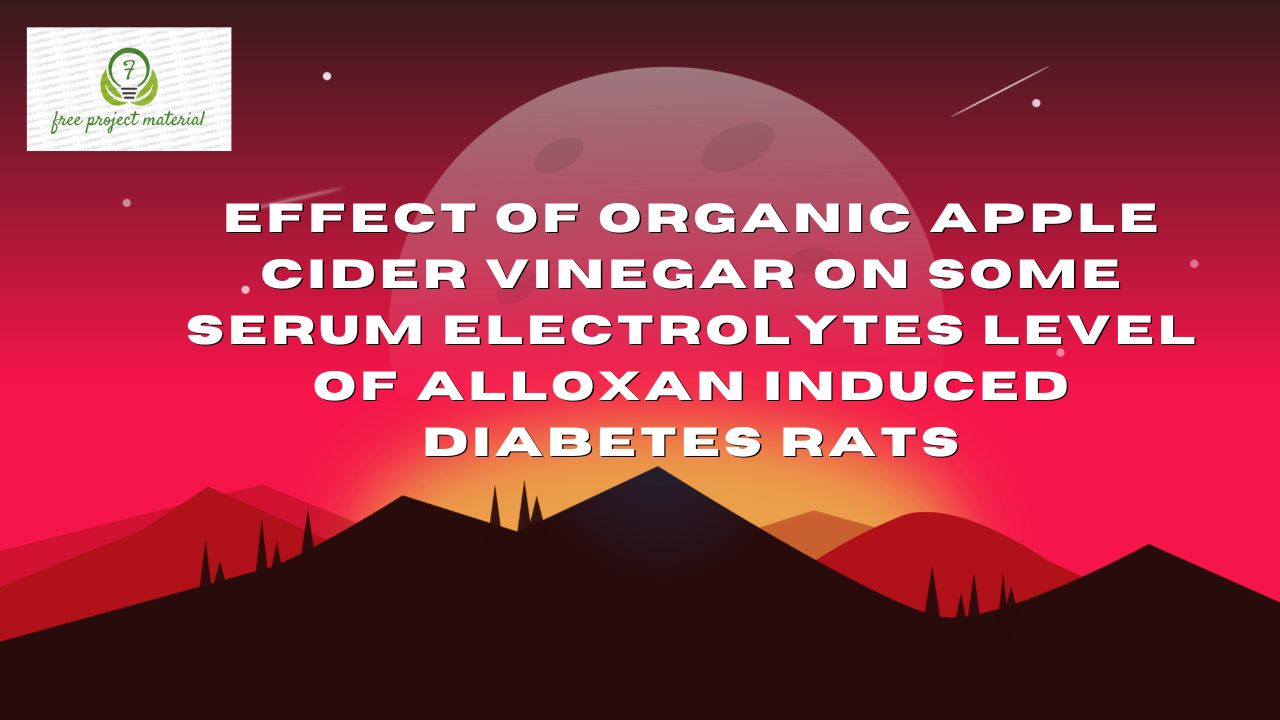ABSTRACT
The study was designed to investigate the effect of organic apple cider vinegar on some electrolyte’s levels of alloxan induced diabetic albino Wistar rats. Twenty-five (25) albino Wistar rat with body weight from 74-325g were randomly assigned to 5 groups. Group 1 served as the control and was administered commercial rat chow and distilled water only. Group 2, 3, 4 and 5 were administered with 150mg/kg body weight of alloxan. Thereafter, they were treated with commercial rat chow and distilled water. Groups 2, 3, 4 and 5 were treated with 0.5 ml, 1.0ml and 1.5ml of 10% organic apple cider vinegar respectively to every other day for 21 days. All the animal were allowed free access to commercial rat chow and water ad libitum. The result revealed that sodium level in groups 2, 3 and 5 had a significant decrease (P<0.05) when compared to group 1 while group 4 showed a non-significant decrease (P>0.05) when compared to group 1. There was a significant increase in groups 3 and 4 while group 5 non-significantly increase (P>0.05) when compared to group 2. All the groups showed a significant decrease (P<0.05) of potassium except for group 2 which significantly increase (P<0.05) when compared to group 1. All the experimental groups showed a significant decrease (P<0.05) when compared to group 2. Serum level of bicarbonate in group 2 and 4 significantly decrease (P<0.05) and group 3 had a non-significant difference while group 5 non-significantly decrease when compared to group 1. However, group 3 had a significant increase while group 4 had a non-significant decrease (P>0.05). Group 5 non-significantly increase when compared to group 2. Groups 2, 4 and 5 had a significant decrease (P<0.05) in serum chloride level while group 3 showed a non-significant decrease (P<0.05) of serum calcium while group 3 significantly decreased when compared to group 1. All the experimental groups showed a non-significant decrease when compared to group 2. This result suggest that organic apple cider vinegar possesses kidney protective properties and antidiabetic activity as such it could be used as possible antidiabetic drug and find application in ethnomedicine for alleviating kidney impairment.
TABLE OF CONTENTS
Title Page – – – – – – – – i
Certification – – – – – – – – ii
Dedication – – – – – – – – iii
Acknowledgements – – – – – – iv
Abstract – – – – – – – – v
Table of Contents – – – – – – – vi
CHAPTER ONE: INTRODUCTION
1.1 Background of the Study – – – – – – 1
1.2 Aim and Objective of the study – – – – – 6
1.2.1 Aim of the study – – – – – – – 6
1.2.2 Objectives of the Study – – – – – – 6
1.3 Scope and Limitation of the study – – – – 7
1.4 Definition of terms – – – – – – – 8
CHAPTER TWO: LITERATURE REVIEW
2.1 Description of Apple cider vinegar – – – – 10
2.2 Nutritional Value of Apple cider vinegar – – – 11
2.3 Medicinal properties of Apple cider vinegar – – – 12
2.4 Apple cider vinegar production – – – – – 14
2.5 Adverse Effects and interaction Associated with the use of Apple cider vinegar – – – – – – – – 14
2.6 Biochemical function of Electrolyte – – – – 15
2.6.1 Potassium (K–) – – – – – – – 17
2.6.2 Calcium (Ca+) – – – – – – – 18
2.6.3 Chloride (Cl–) – – – – – – – 20
2.6.4 Bicarbonate HCO3 – – – – – – – 22
2.7 Factors Affecting – – – – – – – 23
2.8 Alloxan and its Biological Effects – – – – 25
2.9 Mechanism of Alloxan-induced diabetes – – – 26
CHAPTER THREE: MATERIALS AND METHODS
3.1 Materials – – – – – – – – 30
3.2 Methods – – – – – – – – 30
3.2.1 Sample collection – – – – – – – 30
3.2.2 Sample Preparation – – – – – – 31
3.2.3 Experimental Design and Grouping of animals – – 32
3.2.4 Blood sample collection – – – – – – 33
3.3 Determination of Biochemical parameters – – – 34
3.3.1 Determination of sodium serum – – – – – 34
3.3.2 Determination of potassium serum – – – – 36
3.3.3 Determination of calcium serum – – – – 37
3.3.4 Determination of chloride serum – – – – 38
3.3.5 Determination of Bicarbonate serum – – – – 39
3.4 Statistical Analysis – `- – – – – 40
CHAPTER FOUR: RESULTS AND DISCUSSION
4.1 Results – – – – – – – – 41
4.2 Discussion – – – – – – – 43
CHAPTER FIVE: CONCLUSION AND RECOMMENDATIONS
5.1 Conclusion – – – – – – – 49
5.2 Recommendations – – – – – – – 50
References
CHAPTER ONE: INTRODUCTION
1.1 Background of the Study
Apple cider vinegar otherwise known as cider vinegar or ACV, is a type of vinegar made from cider or apple must and has a pale medium color. Unpasteurized or organic ACV contains mother of vinegar. Apple cider vinegar is fermented juice from crushed apples. Like apple juice, it likely contain some pectin, vitamin b1, vitamin b2, and vitamin b6, biotin, folic acid, niacin pantothenic acid and vitamin c. Preliminary research is being conducted to determine possible effects on blood glucose levels, satiety, anti-infective properties(either topically or orally) and hypertension or cancer, ingestion of the acetic acid in vinegar poses a risk of possible injury to soft tissues of the mouth, throat, and stomach. Uses for topical treatment, cleaning solutions, or eye accidents are included as warnings under poison advisories. In order to prevent diabetes, in addition to oral hypoglycaemic drugs the dietary component such as apple cider vinegar seems to be promising for glycolic control in patient with Type 2 diabetes as well as for diabetes related medical conditions (Khan et al., 2003, Anderson et al., 2020 and Sultan et al., 2012).
Many medicinal components that are good for health have been reported in natural vinegar, such as carbohydrate, organic acid (acetic, formic, lactic, malic, citric, succinic and tartaric). Alcohols and minerals salts, polyphenolic compounds (gallic acid, catechin, caffeic, ferulic acid). Different types if vinegar is produced from regional foods according to well established customs. Different types of vinegar are available in market. Traditional vinegar is produced from regional foods according to well established customs. The balsamic vinegar of Modena, Italy is made from the local white Trebbiano grapes. Traditional rice wine vinegar is produced in Asia, coconut and cane vinegar is common in India and Phillippines and date vinegars are popular in the Middle East. Some scientific investigation clearly states the benefits of vinegar such as antimicrobial properties (Vijayakumar and Wolf Hall., 2002), prevent inflammation and hypertension (Murooka and Yamshita, 2008), lower serum cholesterol (Fushimi et al., 2006), reduction in systolic blood pressure (Konda et al., 2000), enhanced calcium absorption and retention, decrease the glycemic index of carbohydrate food for people with and without diabetes (Sugiyama et al., 2003; Johnston et al., 2004). Antiglycemic effects of vinegar have been known for more than a century and have been demonstrated in animal as well as human studies (Salbe et al., 2009).
According to recent estimates, diabetes mellitus is a growing problem. Over 171 million people were living with diabetes worldwide in the year 2000, and the estimated number is to increase to 366 million by 2030 (Roglic, 2004). Diabetes mellitus has been defined as a chronic disease with persistently elevated blood glucose concentration (Greenbaum, 2008). It is a major and growing public health problem throughout the world. In modern medicine no satisfactory effective therapy is still available to cure diabetes mellitus, which is a syndrome resulting from a variable interaction of hereditary and environmental factors and characterized by abnormal insulin secretion or insulin receptor or post-receptor events affecting metabolism involving carbohydrates, proteins and fats in addition to damaging β-cells of pancreas, liver and kidney in some cases (Ghosh and Surawanshi, 2002).
Management of diabetic patients depends on the dietary and lifestyle factors where they play an important role not only in the etiology but also in the control of the disease and its complication (Xuemi et al., 2012). Liver disease is one of the dealing causes of death in persons with type 2 diabetes. The standardized mortality rate death from liver disease is greater than that cardiovascular disease. The spectrum of liver disease in type 2 diabetes ranges from nonalcoholic fatty liver disease to cirrhosis and hepatocellular carcinoma (Keith et al., 2004). Experimental type1 diabetes induced with streptozotocin or alloxan in rats displays many features seen in human subjects with uncontrolled diabetes mellitus (Chattopadhyay et al., 1997). Streptozotocin induced diabetes mellitus in many animals species has been reported to resemble human hyperglycemic nonketonic diabetes mellitus (Weir et al., 2001). Many studies have shown an association between specific diabetic complications and disturbances in various tissues, such as diabetic nephropathy and peripheral neuropathy, but only limited data is available on the possible association between diabetic complication and liver functions (Arkkila et al., 2001).
Cells use electrolytes to conduct electrical charges, which is how your muscles contract. Those same electrical charges also help with chemical reactions, especially when it comes to hydration and the balance of fluids inside and outside of cells.
The key principle that electrolytes rely on is that certain chemical elements can naturally hold a positive or a negative electrical charge when those elements are dissolved in a liquid, that liquid can then conduct electricity.
An example of this is salt water, which conducts electricity easily. Salt consists of sodium (positively charged) and chlorine (negatively charged), and when combined, their charges balance each other out. Atoms with an electrical charge are called ions (positive ions are called cations, while negative ions are called anions).
Dissolving salt in water splits the sodium and chlorine atoms apart, which means they go back to being positively and negatively charged. Electricity jumps between the sodium and chlorine ions not the water molecules because they have opposite electrical charges.
At the most basic chemical level, electrolytes help the body maintain balance. Just like electricity uses ions to travel from place to place in salt water, your body uses ions to transport chemical compounds in and out of cells.
Diabetes is chronic metabolic disorder characterized by high levels of glucose (sugar) in the blood. It occurs when the body either does not produce enough insulin or is unable to effectively use the insulin it produces.
1.2 Aim and Objectives of the Study
1.2.1 Aim of the Study
The aim of the study is to investigate the effect of organic Apple cider vinegar on some serum level of Electrolytes in Alloxan-induced diabetes rats.
1.2.2 Objectives of the Study
- To investigate the effect of organic apple cider vinegar on sodium ion levels in alloxan induced diabetes rats.
- To investigate the effect of organic apple cider vinegar on calcium ion levels in alloxan induced diabetes rats.
- To investigate the effects of organic apple cider vinegar on potassium ion levels in alloxan induced diabetes rats
- To investigate the effects of organic apple cider vinegar on chloride ion in alloxan induced diabetes rats
- To investigate the effects of organic apple cider vinegar on Bicarbonate ion levels in alloxan induced diabetes rats.
1.3 Scope and Limitation
Scope
This study is focused on examining the effects of organic apple cider vinegar on specific serum electrolytes levels in alloxan-induced diabetic rats and assessing the potential therapeutic benefits of organic apple cider vinegar on diabetes-related electrolyte imbalances.
Limitations
- The study is limited to animal models (alloxan-induced diabetes rats) and may not directly translate to human subjects.
- The findings may not fully represent the complexities and variations seen in human diabetes.
- The study focuses on specific serum electrolyte levels and may not consider other important physiological factors.
- The study does not account for individual variations in response to organic cider vinegar.
1.4 Definition of terms
Effects: The term “effect” refers to the result or consequence of an action, event or condition, it represents the change or impact that occurs as a result of something else, effects can be positive, negative or neutral depending on the context.
Organic: This is describe as anything that is natural, unadulterated or free from artificial additives or processing example organic products may refer to food, cosmetics or other consumer goods that are made from natural ingredients without synthetic chemicals or preservatives.
Apple Cider Vinegar: This is a type of vinegar made from fermented apple juice.
Serum: Refers to the liquid component of blood after it has clotted and the blood cell has been removed, it is a clear, yellowish fluid. These contain various substances including electrolyte.
Electrolytes: This is a chemical that conduct electricity when dissolved in a liquid such as water.
Alloxan: Is a chemical compound that is commonly used in scientific research to induce diabetes in animal models, particularly in rodents.


